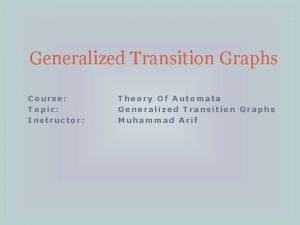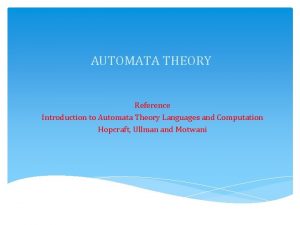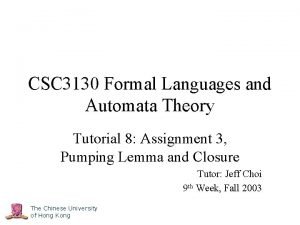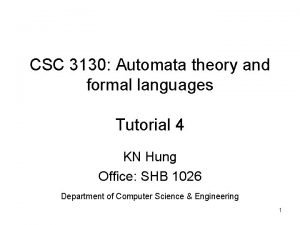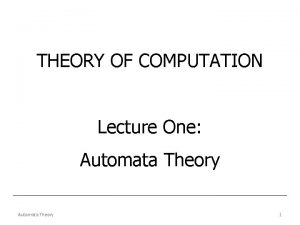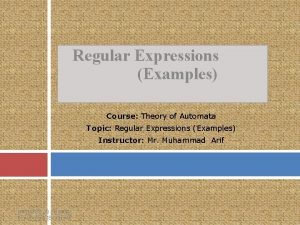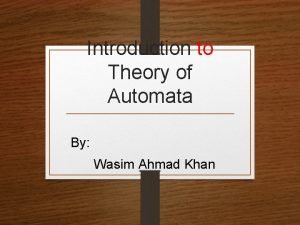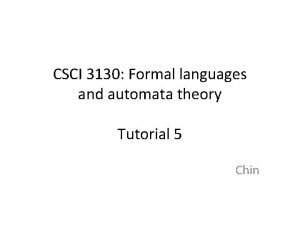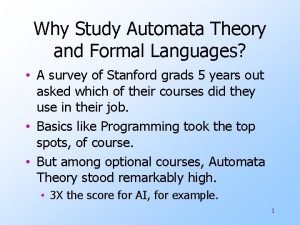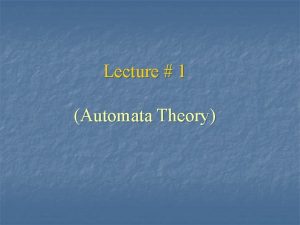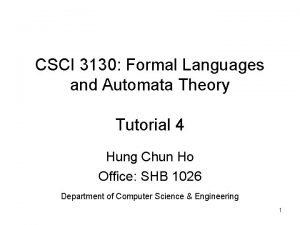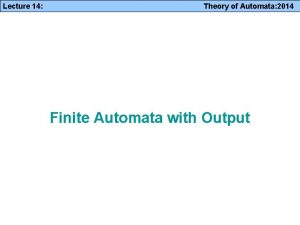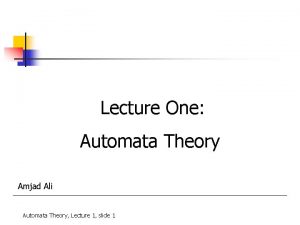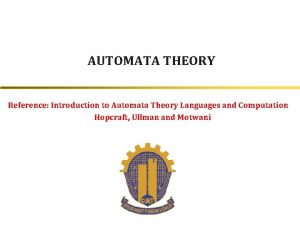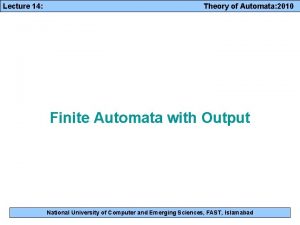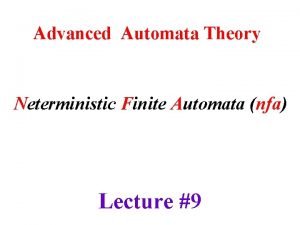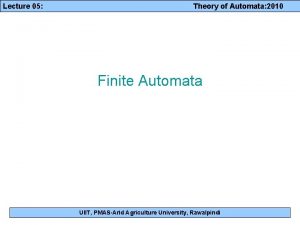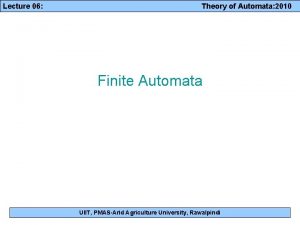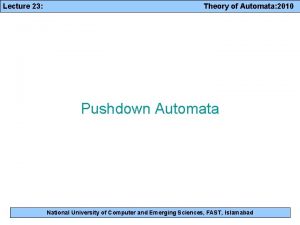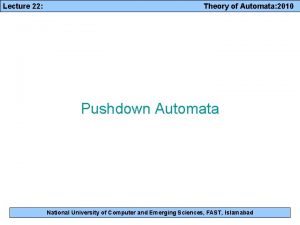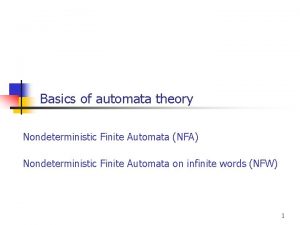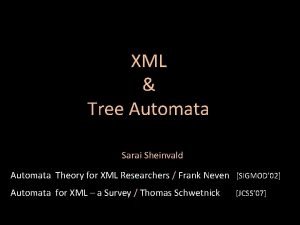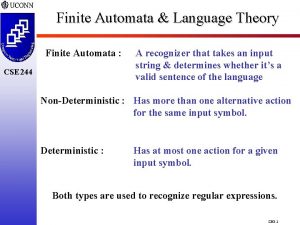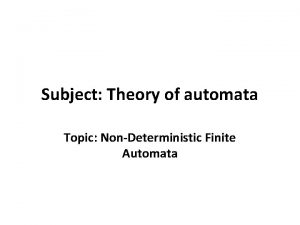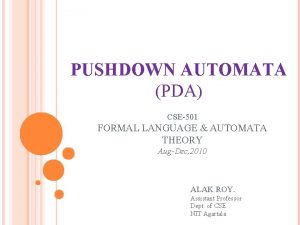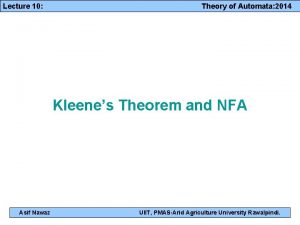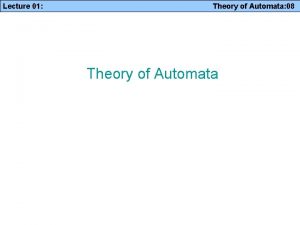Lecture 04 Theory of Automata 2014 Theory of




















- Slides: 20

Lecture 04: Theory of Automata: 2014 Theory of Automata Asif Nawaz

Lecture 04: Theory of Automata: 2014 Example • The following equivalences show that we should not treat expressions as algebraic polynomials: (a + b)* = (a + b)* + a* (a + b)* = (a + b)* = a(a + b)* + b(a + b)* + Λ (a + b)* = (a + b)*ab(a + b)* + b*a* • The last equivalence may need some explanation: – The first term in the right hand side, (a + b)*ab(a + b)*, describes all the words that contain the substring ab. – The second term, b*a* describes all the words that do not contain the substring ab (i. e. , all a’s, all b’s, Λ, or some b’s followed by some a’s). Theory Of Automata Asif Nawaz 2

Lecture 04: Theory of Automata: 2014 Example • Let V be the language of all strings of a’s and b’s in which either the strings are all b’s, or else an a followed by some b’s. Let V also contain the word Λ. Hence, V = {Λ, a, b, ab, bb, abb, bbb, abbb, bbbb, …} • We can define V by the expression b* + ab* where Λ is included in b*. • Alternatively, we could define V by (Λ + a)b* which means that in front of the string of some b’s, we have either an a or nothing. Theory Of Automata Asif Nawaz 3

Lecture 04: Theory of Automata: 2014 Example contd. • Hence, (Λ + a)b* = b* + ab* • Since b* = Λ b*, we have (Λ + a)b* = b* + ab* which appears to be distributive law at work. • However, we must be extremely careful in applying distributive law. Sometimes, it is difficult to determine if the law is applicable. Theory Of Automata Asif Nawaz 4

Lecture 04: Theory of Automata: 2014 Product Set • If S and T are sets of strings of letters (whether they are finite or infinite sets), we define the product set of strings of letters to be ST = {all combinations of a string from S concatenated with a string from T in that order} Theory Of Automata Asif Nawaz 5

Lecture 04: Theory of Automata: 2014 Example • If S = {a, aaa} and T = {bb, bbb} then ST = {abb, abbb, aabbb, aaabbb} • Note that the words are not listed in lexicographic order. • Using regular expression, we can write this example as (a + aaa)(bb + bbb) = abb + abbb + aabbb + aaabbb Theory Of Automata Asif Nawaz 6

Lecture 04: Theory of Automata: 2014 Example • If M = {λ, x, xx} and N = {λ, y, yyy, yyyy, …} then • MN ={λ, y, yyy, yyyy, …x, xyy, xyyyy, …xx, xxyy, xxyyyy, …} • Using regular expression (λ + xx)(y*) = y* + xxy* Theory Of Automata Asif Nawaz 7

Lecture 04: Theory of Automata: 2014 Languages Associated with Regular Expressions Asif Nawaz

Lecture 04: Theory of Automata: 2014 Definition • The following rules define the language associated with any regular expression: • Rule 1: The language associated with the regular expression that is just a single letter is that one-letter word alone, and the language associated with λ is just {λ}, a one-word language. • Rule 2: If r 1 is a regular expression associated with the language L 1 and r 2 is a regular expression associated with the language L 2, then: (i) The regular expression (r 1)(r 2) is associated with the product L 1 L 2, that is the language L 1 times the language L 2: language(r 1 r 2) = L 1 L 2 Theory Of Automata Asif Nawaz 9

Lecture 04: Theory of Automata: 2014 Definition contd. • Rule 2 (cont. ): (ii) The regular expression r 1 + r 2 is associated with the language formed by the union of L 1 and L 2: language(r 1 + r 2) = L 1 + L 2 (iii) The language associated with the regular expression (r 1)* is L 1*, the Kleene closure of the set L 1 as a set of words: language(r 1*) = L 1* Theory Of Automata Asif Nawaz 10

Lecture 04: Theory of Automata: 2014 Finite Languages Are Regular Asif Nawaz

Lecture 04: Theory of Automata: 2014 Theorem 5 • If L is a finite language (a language with only finitely many words), then L can be defined by a regular expression. In other words, all finite languages are regular. • Proof • Let L be a finite language. To make one regular expression that defines L, we turn all the words in L into boldface type and insert plus signs between them. • For example, the regular expression that defines the language L = {baa, abbba, bababa} is baa + abbba + bababa • This algorithm only works for finite languages because an infinite language would become a regular expression that is infinitely long, which is forbidden. Theory Of Automata Asif Nawaz 12

Lecture 04: Theory of Automata: 2014 How Hard It Is To Understand A Regular Expression Let us examine some regular expressions and see if we could understand something about the languages they represent. Asif Nawaz

Lecture 04: Theory of Automata: 2014 Example • Consider the expression (a + b)*(aa + bb)(a + b)* =(arbitrary)(double letter)(arbitrary) • This is the set of strings of a’s and b’s that at some point contain a double letter. Let us ask, “What strings do not contain a double letter? ” Some examples are λ; a; b; ab; ba; aba; bab; abab; baba; … Theory Of Automata Asif Nawaz 14

Lecture 04: Theory of Automata: 2014 Example contd. • The expression (ab)* covers all of these except those that begin with b or end with a. Adding these choices gives us the expression: (λ + b)(ab)*(λ + a) • Combining the two expressions gives us the one that defines the set of all strings (a + b)*(aa + bb)(a + b)* + (λ + b)(ab)*(λ + a) Theory Of Automata Asif Nawaz 15

Lecture 04: Theory of Automata: 2014 Examples • Note that (a + b*)* = (a + b)* since the internal * adds nothing to the language. However, (aa + ab*)* ≠ (aa + ab)* since the language on the left includes the word abbabb, whereas the language on the right does not. (The language on the right cannot contain any word with a double b. ) Theory Of Automata Asif Nawaz 16

Lecture 04: Theory of Automata: 2014 Example • Consider the regular expression: (a*b*)*. • The language defined by this expression is all strings that can be made up of factors of the form a*b*. • Since both the single letter a and the single letter b are words of the form a*b*, this language contains all strings of a’s and b’s. That is, (a*b*)* = (a + b)* • This equation gives a big doubt on the possibility of finding a set of algebraic rules to reduce one regular expression to another equivalent one. Theory Of Automata Asif Nawaz 17

Lecture 04: Theory of Automata: 2014 Introducing EVEN-EVEN • Consider the regular expression E = [aa + bb + (ab + ba)(aa + bb)*(ab + ba)]* • This expression represents all the words that are made up of syllables of three types: type 1 = aa type 2 = bb type 3 = (ab + ba)(aa + bb)*(ab + ba) • Every word of the language defined by E contains an even number of a’s and an even number of b’s. • All strings with an even number of a’s and an even number of b’s belong to the language defined by E. Theory Of Automata Asif Nawaz 18

Lecture 04: Theory of Automata: 2014 Algorithms for EVEN-EVEN • We want to determine whether a long string of a’s and b’s has the property that the number of a’s is even and the number of b’s is even. • Algorithm 1: Keep two binary flags, the a-flag and the b-flag. Every time an a is read, the a-flag is reversed (0 to 1, or 1 to 0); and every time a b is read, the b-flag is reversed. We start both flags at 0 and check to be sure they are both 0 at the end. • Algorithm 2: Keep only one binary flag, called the type 3 -flag. We read letter in two at a time. If they are the same, then we do not touch the type 3 -flag, since we have a factor of type 1 or type 2. If, however, the two letters do not match, we reverse the type 3 -flag. If the flag starts at 0 and if it is also 0 at the end, then the input string contains an even number of a’s and an even number of b’s. Theory Of Automata Asif Nawaz 19

Lecture 04: Theory of Automata: 2014 • If the input string is (aa)(ab)(bb)(bb)(bb)(ab)(ba)(a a) then, by Algorithm 2, the type 3 -flag is reversed 6 times and ends at 0. • We give this language the name EVEN-EV EN. so, EVEN-EV EN ={λ, aa, bb, aaaa, aabb, abab, abba, baab, baba, bbaa, bbbb, aaaaaa, aaaabb, aaabab, …} Theory Of Automata Asif Nawaz 20
 01:640:244 lecture notes - lecture 15: plat, idah, farad
01:640:244 lecture notes - lecture 15: plat, idah, farad Gtg in theory of automata
Gtg in theory of automata The central concepts of automata theory
The central concepts of automata theory Bidirectional transducers in automata theory
Bidirectional transducers in automata theory Csci3130
Csci3130 Formal languages and automata theory tutorial
Formal languages and automata theory tutorial Csc3120 datasheet
Csc3120 datasheet Automata theory
Automata theory Automata theory
Automata theory Is regular expression a language
Is regular expression a language Valid and invalid alphabets in automata
Valid and invalid alphabets in automata Automata theory tutorial
Automata theory tutorial Automata theory
Automata theory Csci 3130
Csci 3130 Aaaaaabb
Aaaaaabb Automata theory stanford
Automata theory stanford Reverse of a string in automata theory
Reverse of a string in automata theory Automata theory tutorial
Automata theory tutorial Natural language processing
Natural language processing Decision theory lecture notes
Decision theory lecture notes Sargur srihari
Sargur srihari

